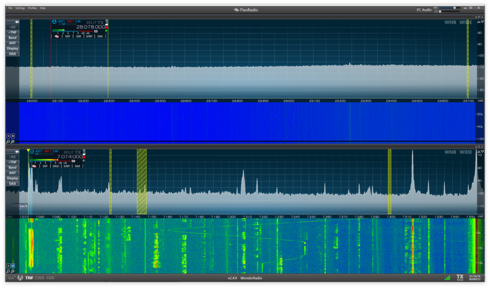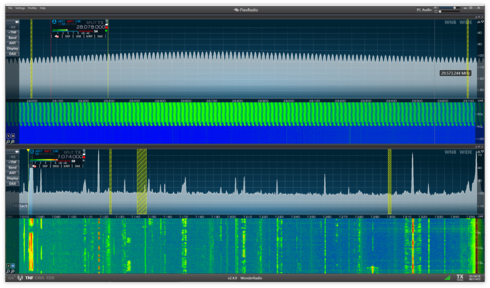SmartSDR v4.1.3 | SmartSDR v4.1.3 Release Notes
SmartSDR v3.10.15 | SmartSDR v3.10.15 Release Notes
The latest 4O3A Genius Product Software and Firmware
Need technical support from FlexRadio? It's as simple as Creating a HelpDesk ticket.
Furnace Blower RFI - Suggestions?
I have a 1.5 yr old Goodman furnace that has an ECM blower motor. In diagnosing the situation, when at the furnace and watching my waterfall, 10m gets blown out as visualized below (2nd one) the moment the relay flips and blower starts moving. These aren't birdies they are a flock!


I am in the process of working with installer and mfg but it's not looking promising.
I have found these two articles and am headed down a path of suppressing RFI on the wires to the motor- hoping its there.... Curious if any of you have seen such a signature and have any tips as I hate to stumble around for months to sort this out - although the 10m prop is shot for a year or two more so I guess I have time....
Resolving Furnace and A/C RFI (Radio Frequency Interference) - ARRLwww.arrl.org/files/file/.../Solving%20Furnace%20and%20AC_RFI_KM4LHZ_v9.pdf
https://www.eham.net/articles/32146
Thanks,
-Dave
Answers
-
It's amazing how this stuff passes FCC certification? And yet when an amateur radio company wants to make a new radio or amp they put the screws to them.
Well good luck, looks like that RFI motor filter will help a lot.
0 -
Hmm, never thought about that. I have some unsolved RFI, will keep my furnace blower in mind.
0 -
Dave, I can't see the frequency range of the EMI on 10M, but it appears quite large. Can you please clarify the range? In my experience with Trane ECM units, the EMI signature is a series of perhaps 50 closely spaced pulses spread across approximately 1 KHz. These groups of pulses are approximately 18 KHz apart and repeat over several MHz of the HF spectrum.
The attached presentation by KM4LHZ is EXCELLENT and mirrors my experience in virtually every way. Be careful to explore ALL the wires that exit the metal enclosures as they can easily be antennas conducting the EMI to the outside world.. If you happen to have motors manufactured by Regal Beloit, you are fortunate. The engineering staff was very supportive five+ years ago when I encountered problems with their motors.
I suggest you follow the analysis and resolution recommendations in the paper and report your progress, good or bad, so readers here may offer their experience.
---
Chuck, AE4CW
2 -
Chuck Appx 24.8 to 31.8 MHz. So 7mhz. Huge. Peaks every 15 kHz. It seems like such a large range vs what others including you mention seeing. I do have to ferret out the motor mfg. one can hope it is the same mfg. Really the only wires exiting the enclosure are Thermostats and power. But will keep them in suspicion.
 0
0 -
Dave, Have you looked at whole house AC filters something like the Morgan 330 units, http://www.surgestop.com/surge-products/m-330.html . I think someone else now builds there products - I have a few of the 400 series and they seem to work at taking out or reducing issues I have had. and will probably add the 330 as well.1
-
My washer/dryer combo did this until i put some mix 31 snap ons on the 240vac power cable right up to the back panel. This prevents the motor that is emmitting rfi to use the power cable as an antenna and transmit it farther and stronger.1
-
When my new furnace had this problem several years ago, the following steps helped.
The manufacturer had a "RFI kit" available to installers, and it was basically just an
AC line filter. It helped. I then used a small loop as an antenna "sniffer" as I tried to
see where the noise was coming from, even taking the front panel off. The motor wires
were the worst, so I replaced them with a "twisted pair" with a small ferrite at each
end and the noise was reduced to negligible levels at my antennas.
3 -
I had the same problem.. Popped open the inside unit and installed 10 split ferrites Mix 31 on all wiring harnesses that I could get to..... including wires to thermostat (great antenna). Problem is history.1
-
Same issue here, although the spectrum looks different. I am still trying to get my Trane service company to actually understand what I am talking about. :-(
Anway, here is how my Heatpumps look like on 20 and 15
73
Andy
KU7T
0 -
Dave,
I have seen the EMI extend 7 MHz and more. The peaks from the EMI emitting motors consists of clusters of many very narrow pulses (~50) spanning approximately 1 KHz. And, these pulse group repeated approximately every 18 KHz over many MHz. The noise signature I see in your photo above is different from anything I have seen coming from my HVAC motors.
Chuck
1 -
Moral of the story..... Don't buy a Goodman furnace.
My installer wanted to help but it was beyond their expertise. They reached out to Goodman and they said "dunno". Called Goodman customer support and they said call installer. So dead ends everywhere. Sadly I didn't have the motor referenced in the above articles....
So I went to Mouser and loaded up on all sorts of ferrite's.
Clip on's only marginally made a difference. The real winner-=> Ferrite Rings:
I was luck enough to have enough wire play to take each wire and wrap it 7times thru a ferrite ring. Problem solved and all noise gone. Wasn't the power nor the thermostat wires resonating; it was the PCM motor. As we know impedance of a choke is proportional to the square of the number of turns. 7 turns was my magic and thankfully enough wire for it.
Here's a pic of the fix:
I used some zip ties to carry the weight of the ferrite rings so as not to unduly stress the wires up at the motor.
So when in doubt, ask a Ham. We can fix it!
10m is blessedly quiet now when the motor is running. Now if only some Sporadic E would show up!
73's.2 -
After reading the various comments and sujestions, most are what I would have done, there is one more thing you should do. Report this to your FCC field office and give them all the details of what you have done. With the current political regime in office. All prevention regulations at the various regulatory agencies have changed to self regulation policy. So the only way to get action on an issue is to report problems or proceed with legal action.1
-
Pat- One of the hot topics in our community besides merits or lack of them for FT8, or people constantly changing call signs and locking them out or.... Is whether this device falls under FCC regulations or not. I find arguments on both sides and struggle to overcome my apathy to convince FCC and MFG of their error For example see slide 30 of the ARRL preso I listed at the start. It claims no standard for incidental emissions below 30mhz. I haven’t found any good examples of how one of us has pursued this path and made a difference. Tnx0
-
The regulations are in chapter 47 / part 15 / paragraph 103 of the Federal Regulations. This is a link to the FCC clarifying the rules relative home appliances:
https://apps.fcc.gov/oetcf/kdb/forms/FTSSearchResultPage.cfm?switch=P&id=33062
A washing machine / dryer is exempt but a hair straightener is not. I wonder who came up with the list...
Be that as it may the last paragraph seems to keep the MFG on the hook for RFI problems:
"An exempt appliance is only exempt from equipment authorization procedures for the functions associated with the digital device circuitry. The appliance remains subject to the requirements in Section 15.5 requiring the device not cause harmful interference"
_..--
TiM1 -
I may have the same problem but from a neighboring building. Roughly for 11- 15 minutes at a times, I get interference mostly on 40M all day and into the night (go to bed early if I can). I included a link to the video or just check AB9UU.USA on YouTube. I think it might be the furnace motor of the building across the street but am unsure so far. It is cold out now (below 0 F tonight - ouch) and the furnace motor may be running at these intervals unless it is something else. When I turn my Hexbeam between 340 and 20 degrees and select 40 meters, I get the interference in the video though the video is from my End Fed antenna. Still, it looks very similar. You can even see the "switching on" of the interference. I still need to pin point it but I believe it is the building across the street as it is in the degree range of the Hexbeam pattern. https://youtu.be/zQrHS88q-dM
0
Leave a Comment
Categories
- All Categories
- 381 Community Topics
- 2.1K New Ideas
- 632 The Flea Market
- 8.3K Software
- 127 SmartSDR+
- 6.4K SmartSDR for Windows
- 185 SmartSDR for Maestro and M models
- 430 SmartSDR for Mac
- 272 SmartSDR for iOS
- 259 SmartSDR CAT
- 195 DAX
- 382 SmartSDR API
- 9.4K Radios and Accessories
- 40 Aurora
- 265 FLEX-8000 Signature Series
- 7.2K FLEX-6000 Signature Series
- 955 Maestro
- 56 FlexControl
- 866 FLEX Series (Legacy) Radios
- 927 Genius Products
- 464 Power Genius XL Amplifier
- 338 Tuner Genius XL
- 125 Antenna Genius
- 297 Shack Infrastructure
- 209 Networking
- 460 Remote Operation (SmartLink)
- 144 Contesting
- 788 Peripherals & Station Integration
- 140 Amateur Radio Interests
- 1K Third-Party Software



